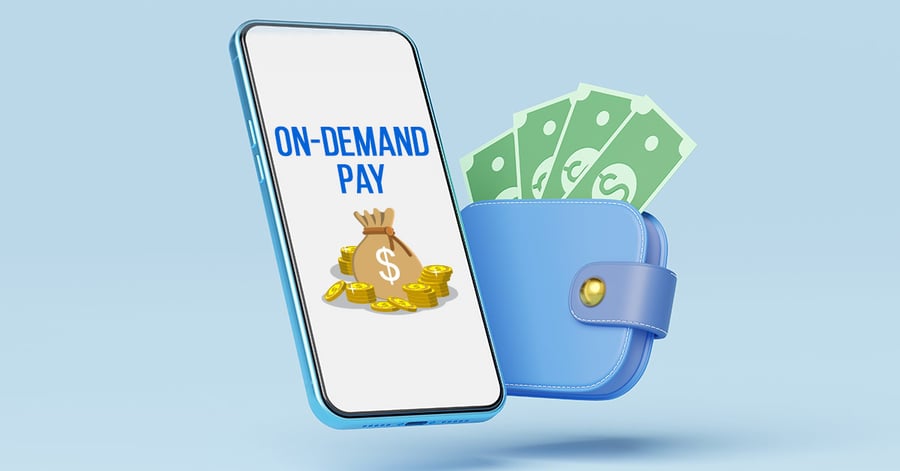
- Home
- Global Payroll
- On-demand pay - The innovation in payroll
On-demand pay - The innovation in payroll
Published :

On-demand pay is a method of paying employees, where they receive their wages as they earn them. On-demand pay ensures that the employees are paid their wages before the next scheduled payday. It enables employees to receive either one day’s pay or the accumulated dues of their earnings thus far.
Technology makes it possible to provide employees with on-demand pay. The money owed to the employees (also called their ‘pay balance’) is directly delivered to them the day it is earned. On-demand pay is driven by the motivation to shield employees from financial stress - leading to happier, more productive, and better-engaged employees.
The rising living expenses, the high cost of healthcare, and having to cater to unforeseen contingencies make managing personal finances a daunting challenge.
Despite the many innovations in various work processes and the digitization of payroll, the underlying philosophy of payroll has remained essentially unchanged and archaic. Most firms pay their employees on a weekly/fortnightly/monthly basis.
Typically, firms do not compute payroll in real-time. Payroll software now enables firms and payroll providers to compute the pay an employee is owed, after-tax, every day in real-time. This payment is credited to the employee’s bank account or payment card. Some providers charge a meager fee (typically equal to an ATM fee) for providing on-demand pay.
On-demand pay provides employees the flexibility to decide when and how they want to get paid. In addition, this facility benefits lower-income employees as it provides quicker access to their earnings.
On-demand pay benefits both - the employers and the employees:
The Unseen Drawbacks of On-Demand Pay
On-demand pay is not without its downsides. The drawbacks of on-demand pay include:
| For employees | For employers |
| Fees - Employees may resent having to pay a fee for receiving on-demand the wages they have earned. In instances where the on-demand pay is used to cover some emergency, paying a fee will feel especially irksome. | Computational Errors - Although payroll automation has minimized the probability of computational errors, frequent payments increase the likelihood, howsoever slightly, of errors occurring while calculating wages. |
|
Taxes - Typically, on-demand pay services do not deduct tax on employee withdrawals. However, since withdrawals are not tax-free, the employer deducts the taxes due from the next paycheck. Therefore, the employee receives a lower-than-anticipated paycheck, leading to frustration and resentment. |
Taxes - Employers are responsible for tax deductions on on-demand wages. Failure to do so would attract penalties from tax authorities. |
On-demand pay as a necessary solution for improving the employee experience at the workplace is gaining greater acceptance among payroll professionals.
However, on-demand pay implies that payroll professionals must assume responsibility for the following challenges connected with compliance and processing:
As organizations expand across borders and embrace flexible pay cycles, integrating on-demand pay into their global payroll infrastructure becomes both a necessity and a challenge. To fully leverage on-demand pay capabilities, businesses must ensure their underlying payroll software and payroll services are equipped to handle real-time data processing, tax compliance, and multi-currency disbursements.
One of the primary hurdles in implementing on-demand pay at scale is aligning it with diverse country-specific tax regimes, labor laws, and banking systems. Modern payroll software designed for global payroll management can automate compliance updates, ensuring accurate deductions and statutory filings across jurisdictions. This seamless integration prevents legal complications and helps multinational organizations maintain uniform payroll standards while still offering flexible payout options to employees in different countries.
On-demand pay demands precision, real-time calculations, and dependable systems. Businesses leveraging advanced payroll services can offload the complexity of processing mid-cycle payments, garnishments, and benefits adjustments. These providers often utilize intelligent automation and cloud-based payroll software to track employee earnings, trigger disbursals, and generate up-to-date tax reports — all while minimizing manual intervention and risk.
The Future of Employee-Centric Global Payroll
Embedding on-demand pay into global payroll operations enhances employee experience, particularly for a globally distributed workforce. When backed by robust payroll software and reliable payroll services, this offering boosts retention, supports financial wellness, and reinforces a company’s position as a forward-thinking employer. As workforces become more global and demand personalized benefits, on-demand pay will play a pivotal role in shaping payroll transformation strategies.
Leveraging technology makes it possible to pay employees when and how they need it. As a result, on-demand pay has the potential to be the next big workplace innovation and a source of competitive differentiation.
On-demand pay can be topped up with many financial wellness tools such as savings options, bill payments, retirement planning, etc. If the potential of on-demand pay is fully exploited, it can reach levels of adoption equalling credit cards and exceeding overdrafts.
Interested to learn how you can offer a top-of-the-line on-demand pay service to your employees? Please reach out to us here.
Enterprise asset management (EAM) involves the management of mission critical assets of an organization throughout each asset's lifecycle. EAM is used to plan, optimize, execute, and track the needed maintenance activities with the associated priorities, skills, materials, tools, and information. The aim is to optimize the quality and utilization of assets throughout their lifecycle, increase productive uptime and reduce operational costs.
Enterprise asset management (EAM) involves the management of the maintenance of physical assets of an organization throughout each asset's lifecycle. EAM is used to plan, optimize, execute, and track the needed maintenance activities with the associated priorities, skills, materials, tools, and information.
The software helps in effective maintenance of assets through preventive, predictive, shutdown and breakdown maintenance strategies. The system also helps enterprises mitigate equipment risks by enhanced safety standards. The streamlined operations and improved asset performance helps organizations increase their investment effectiveness.
EAM is important because it helps organizations track, assess, manage and optimize asset quality and reliability. Asset intensive Organizations have hundreds, thousands, even millions of assets which needs to be maintained to maximize / optimize life of these assets to increase the return on investment.
The key features of effective EAM are:
Asset Intensive companies under the following Industries :
Contact us for a meeting and schedule a demo
This differs on case to case basis, based on the type of installation and unique industry specific requirements. Contact us for a meeting and schedule a demo.
This differs on case to case basis, based on the type of installation and unique industry specific requirements. Contact us for a meeting and schedule a demo.
Stay Connected, follow us on LinkedIn / Twitter to know more about EAM Software latest trends.

All Rights Reserved. © Copyright 2024. Ramco Systems.